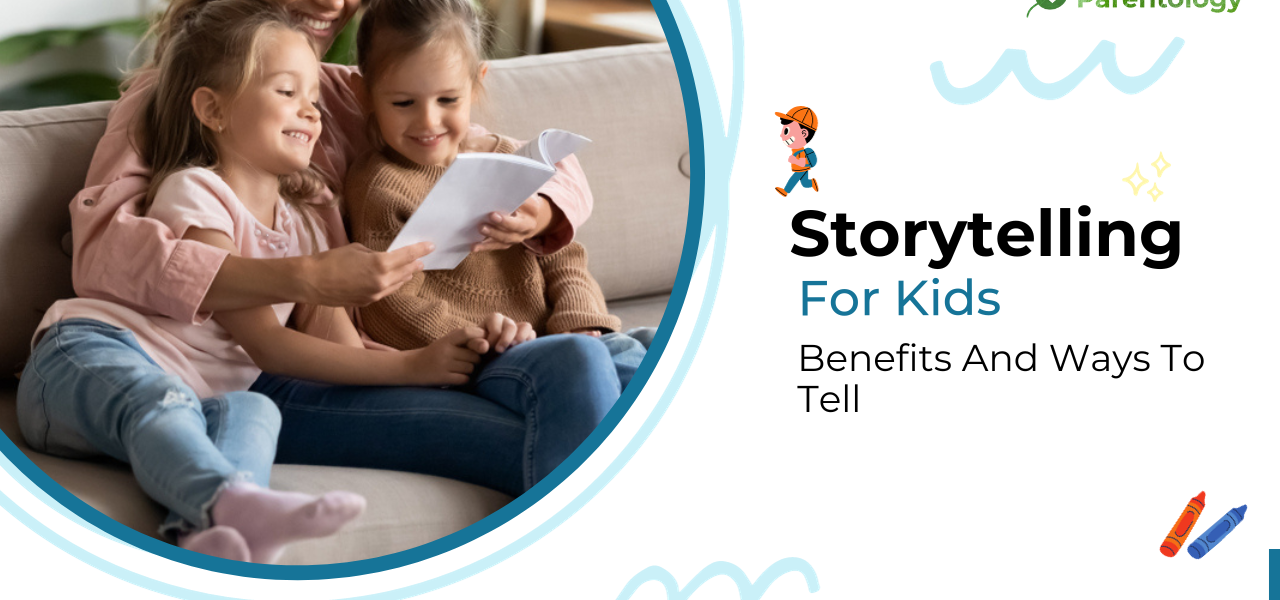Storytelling For Kids: Benefits And Ways To Tell
In the digital age, where screens dominate, nurturing a love for storytelling in kids offers invaluable benefits. Storytelling isn’t just about weaving tales; it’s a powerful tool for enhancing a child’s cognitive, emotional, and social development. From stimulating imagination to fostering empathy, here’s a comprehensive guide to understanding the significance and benefits of storytelling for kids.
The Importance of Storytelling
Storytelling serves as a bridge to connect children with the world around them. It encourages creativity, critical thinking, and emotional intelligence. Through stories, children learn essential life lessons, explore diverse cultures, and develop a sense of empathy. Here’s a deeper dive into the manifold benefits and effective ways to engage young minds in storytelling adventures:
Benefits of Storytelling
1. Stimulates Imagination and Creativity
Storytelling fuels imagination by transporting kids to magical realms, helping them visualize and create their worlds.
2. Enhances Language Skills
Engaging with narratives expands a child’s vocabulary, improves linguistic abilities, and fosters better communication skills.
3. Develops Emotional Intelligence
Stories evoke emotions, teaching kids to understand and manage feelings, promoting empathy and compassion.
4. Encourages Critical Thinking
Analyzing characters, plots, and situations in stories aids in developing analytical and problem-solving skills.
5. Cultivates Moral Values
Stories often convey morals and values, guiding children to differentiate between right and wrong.
6. Boosts Confidence
Encouraging children to narrate their stories or participate in storytelling sessions builds confidence and self-expression.
Ways to Engage Kids in Storytelling
1. Interactive Storytelling Sessions
Conduct interactive storytelling sessions where kids actively participate, adding their twists to the tale.
2. Utilize Visual Aids
Incorporate props, pictures, or puppets to make storytelling more engaging and visually stimulating.
3. Encourage Retelling
Motivate children to retell stories in their words, fostering comprehension and memory skills.
4. Create a Storytelling Corner
Designate a cozy space at home or school where kids can immerse themselves in storytelling adventures.
5. Incorporate Technology Wisely
Use age-appropriate digital resources like storytelling apps or animated eBooks to supplement traditional storytelling methods.
The Impact of Storytelling on Cognitive Development
- Improves Concentration: Engaging narratives capture a child’s attention, enhancing their ability to concentrate for longer periods.
- Develops Memory: Recalling story details, characters, and sequences strengthens memory retention.
- Enhances Sequencing Skills: Understanding the sequence of events in a story aids in logical thinking and sequencing abilities.
- Encourages Problem-Solving: Stories often present dilemmas or challenges, encouraging children to think critically and solve problems.
Utilizing Storytelling for Different Age Groups
- Toddlers and Preschoolers: Simple, repetitive stories with colorful illustrations help in vocabulary building and basic comprehension.
- Elementary School Kids: Engaging in more complex stories with moral lessons, encouraging them to relate to characters and empathize with situations.
- Adolescents: Introduce diverse genres and themes to cater to their evolving interests, fostering analytical thinking and emotional maturity.
Engaging Narratives for Effective Storytelling
- Beginning: A captivating start hooks young listeners, setting the tone for an exciting tale.
- Plot Development: Introduce conflicts, challenges, and characters’ emotions, creating an engaging narrative arc.
- Interactive Elements: Encourage participation by asking questions or leaving cliffhangers, involving children in the storytelling process.
Importance of Parental Involvement
- Family Storytelling Time: Create a family tradition of storytelling, where each member shares their favorite tales, fostering bonding and communication.
- Modeling Storytelling: Parents modeling storytelling behavior encourages children to follow suit, developing their storytelling prowess.
Addressing Common Concerns About Storytelling
- Screen Time vs. Storytelling: While screens offer visuals, traditional storytelling sparks imagination and engagement, making it a unique experience.
- Overcoming Language Barriers: Multilingual storytelling can bridge language gaps, promoting language learning and cultural understanding.
The Power of Story Themes and Characters
- Diverse Themes: Introduce stories addressing various themes like friendship, bravery, kindness, or environmental conservation, expanding children’s perspectives.
- Relatable Characters: Characters that mirror children’s experiences help them connect emotionally, fostering a deeper understanding of the narrative.
Incorporating Storytelling Across Subjects
- Story-Based Learning: Integrate storytelling across subjects like science, history, or math, making learning more engaging and relatable.
- Role of Story in Cultural Education: Stories from different cultures expose children to diversity, fostering cultural appreciation and global awareness.
Creative Storytelling Methods
- Storytelling Through Play: Role-playing or creating scenarios can inspire children to craft stories, enhancing creativity and social skills.
- Digital Story Creation: Encourage kids to create their digital stories using apps or software, promoting tech literacy and storytelling skills.
Interactive Story Elements for Engagement
- Storytelling Games: Incorporate storytelling games or activities like “Story Cubes” or “Finish the Story” to ignite creativity and spontaneity.
- Storytelling Through Arts: Engage children in drawing, painting, or crafting stories, allowing them to express creatively.
Adaptive Storytelling Techniques
- Storytelling for Special Needs: Tailor stories for children with special needs, considering sensory elements, visuals, and pacing for an inclusive experience.
- Multisensory Storytelling: Incorporate sensory experiences like textures, scents, or sounds, creating a multisensory narrative for enhanced engagement.
Storytelling Beyond Entertainment
- Therapeutic Storytelling: Utilize storytelling in therapy to address emotional challenges or behavioral issues, aiding in emotional expression and healing.
- Storytelling for Character Development: Stories featuring strong morals and ethical dilemmas contribute to character-building in children.
FAQs on Benefits of Storytelling for Kids
Q 1. Why is storytelling important for children’s development?
Ans 1: Storytelling nurtures imagination, language skills, emotional intelligence, critical thinking, and moral values in children.
Q 2. How can parents encourage storytelling at home?
Ans 2: Parents can read aloud, engage in storytelling sessions, provide diverse storybooks, and encourage kids to create their narratives.
Q 3. What age is suitable for introducing storytelling to kids?
Ans 3: Storytelling can begin as early as infancy, continuing through childhood and adolescence, adapting to age-appropriate content.
Q 4. How does storytelling contribute to a child’s social skills?
Ans 4: By empathizing with story characters, understanding different perspectives, and participating in group storytelling, kids develop robust social skills.
Q 5. What role does storytelling play in academic success?
Ans 5: Storytelling enhances language proficiency, comprehension, and critical thinking, contributing positively to academic achievements.
Q 6. How can educators integrate storytelling into the classroom effectively?
Ans 6: Educators can incorporate storytelling through read-aloud sessions, drama, puppetry, and creative writing activities.
Q 7. Are there storytelling techniques suitable for shy or reserved children?
Ans 7: For shy children, encourage storytelling through drawing or using props to ease them into storytelling comfortably.
Q 8. Can storytelling aid in building resilience in children?
Ans 8: Yes, narratives showcasing overcoming challenges or adversity can instill resilience and coping skills in children.
Q 9. What role does storytelling play in nurturing empathy in kids?
Ans 9: By connecting with characters’ emotions and experiences, children learn to understand others’ feelings, fostering empathy.
Q 10. How can technology complement traditional storytelling methods?
Ans 10: Technology, when used judiciously, can enhance storytelling through interactive eBooks, audio stories, or multimedia presentations.
Q 11. Are there storytelling resources available online for parents and educators?
Ans 11: Numerous websites offer storytelling resources, including story prompts, creative activities, and tips for effective storytelling.
Conclusion
Storytelling stands as a profound tool in a child’s holistic development. Embracing storytelling opens doors to a world brimming with imagination, creativity, and valuable life lessons, making it an essential aspect of a child’s growth journey.
For more insightful articles on parenting and child development, visit Parentology to explore a myriad of resources.
Remember, storytelling isn’t just about words—it’s about creating magical journeys that shape young minds and nurture a lifelong love for stories.




